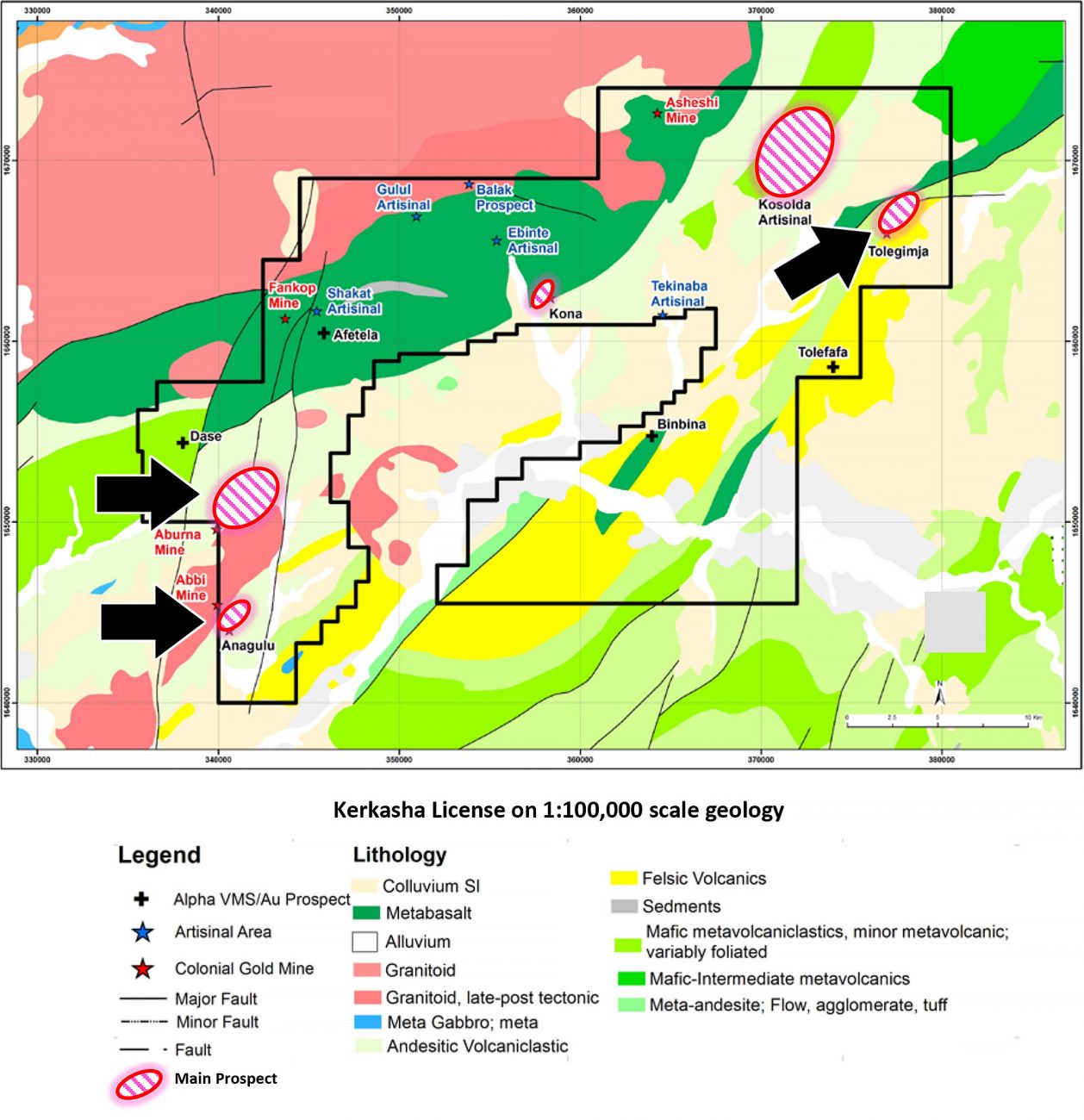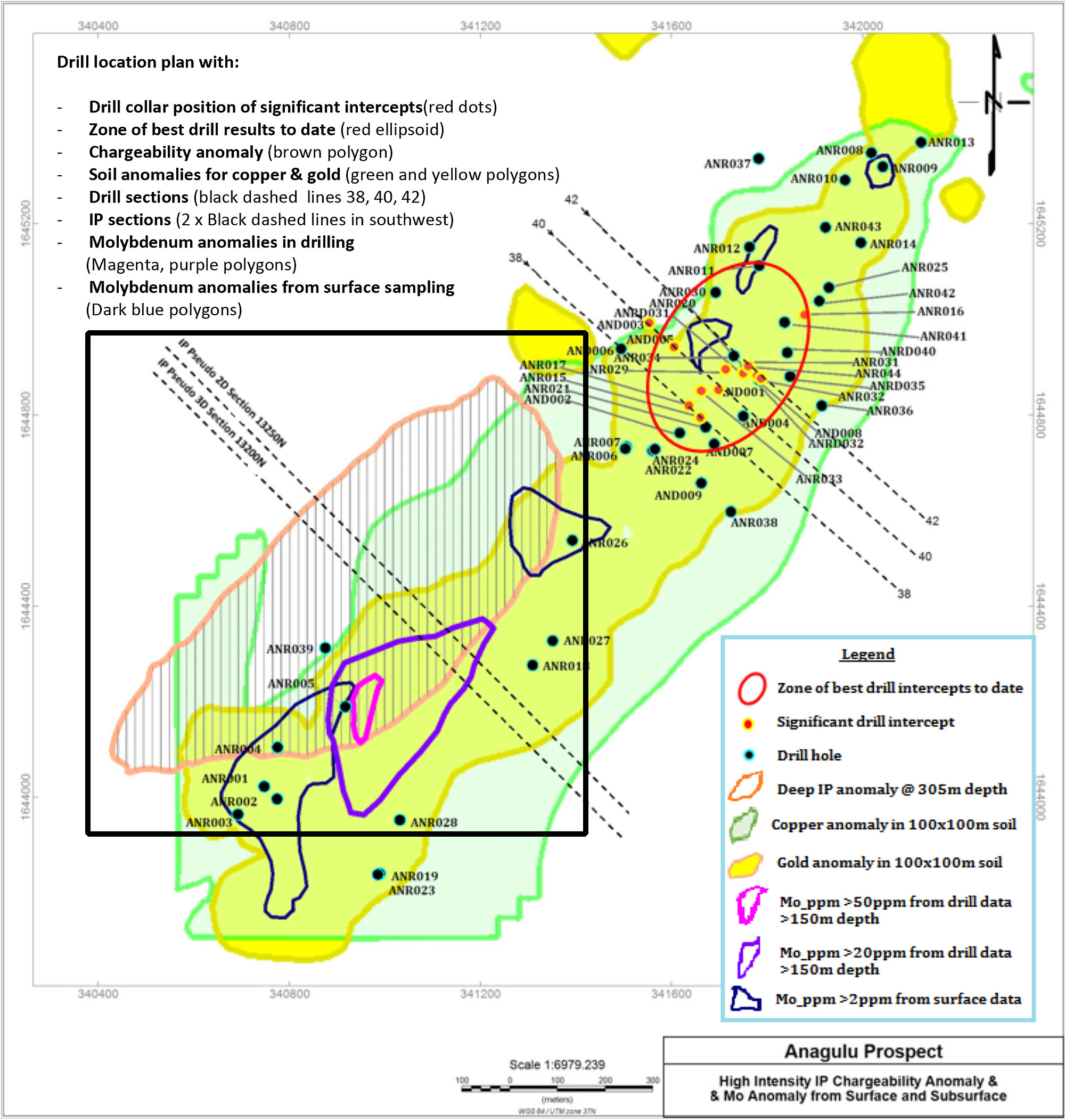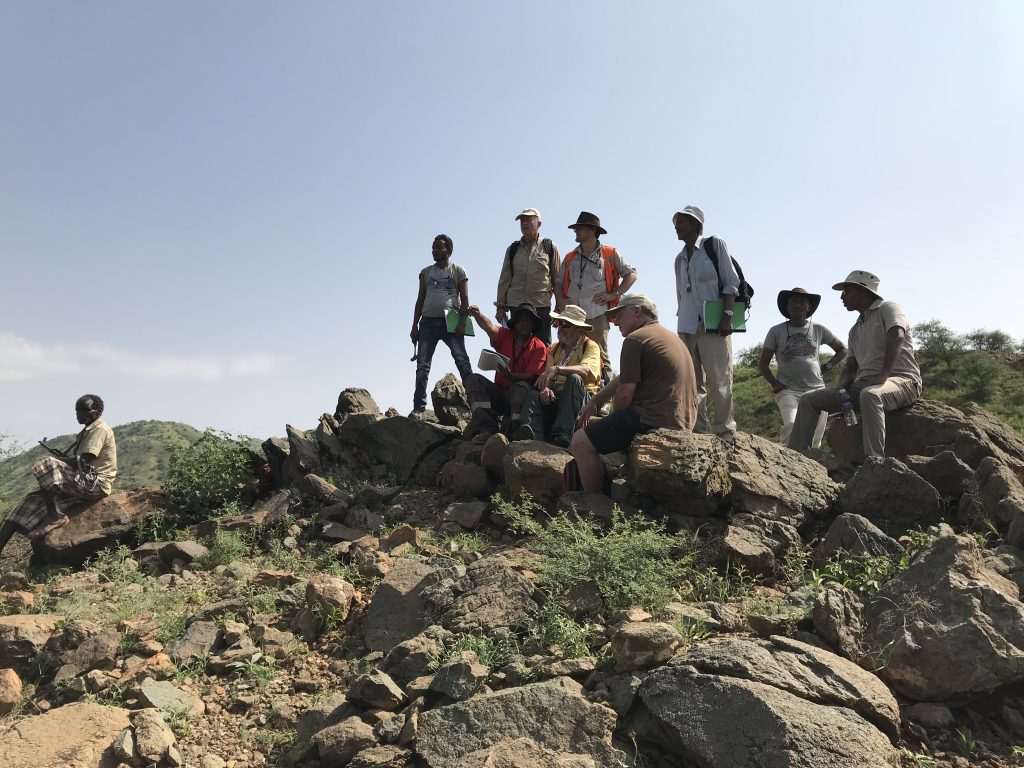
Life isn’t easy for exploration stage companies these days as no one seems to care too much about exploration successes. Drill results go unnoticed and the risk capital simply isn’t as plentiful or available anymore. Alpha Exploration (ALEX.V) has recently drilled some of the higher priority prospects located on its Kerkasha project in Eritrea, but the market shrugged off the results.
Fortunately, Alpha was able to raise C$1.4M in a financing in April of this year, but this really was just the first tranche of a C$5M raise the company was eyeing. As plenty more encouraging exploration results have been published since the previous placement, here’s hoping the company will have an easier time raising funds in the future with additional drill results which confirm the presence of additional significant mineralisation.
A brief recap of the Kerkasha project
It’s perhaps wrong to refer to Kerkasha as a ‘project’ as Alpha Exploration has got its hands on an entire district with a total size of in excess of 770km². For the purpose of this report, we will refer to Kerkasha as ‘the district’ and the separate exploration targets on the Kerkasha license as the ‘separate’ Prospects. Originally in excess of 1,000 square kilometers in size, Alpha reduced the total size of the Kerkasha land package in 2021 by 25% to 771km², as per the requested practices within the Eritrean mining law. Alpha Exploration owns 100% of the license subject to the normal royalties payable to the government as well as a 2% NSR payable to Nubian Royalty.
Kerkasha is located approximately 135 kilometers west-southwest from Asmara, the capital of Eritrea. This isn’t exactly uncharted territory as the district was previously owned and explored under a joint venture between AngloGold-Ashanti (AU) and Thani Investments signed in 2010. That agreement remained in place until 2013 and the data gathered by the two parties allowed Alpha Exploration to ‘kick start’ their own exploration programs. The image below shows how the cumulative exploration expenditures of ~C$17M have identified 17 target areas. Of course, not every single target can be advanced or drilled right now as a non-revenue exploration company needs to make tough choices and Alpha Exploration has zoomed in on three specific areas of interest: Anagulu, Aburna and Tolegimja (highlighted by the arrows on the map below).

Those three high priority targets have recently been drilled and Alpha Exploration is now getting ready to follow up on the very positive assay results returned with additional drill programs.



Alpha has recently drilled some of its high priority targets/prospects, yielding encouraging results
Anagulu
Anagulu was last drilled in July-August 2021 and the company announced the assay results in December of last year. Just to recapitulate why Anagulu is such an interesting prospect: this copper-gold porphyry system seems to be combining grade with size and although it is obviously still very early days on this prospect, Alpha Exploration has encountered some excellent mineralized intervals.
It’s usually true that ‘the first hole will never be the best hole’, but in Alpha Exploration’s case, this still holds true after drilling a few dozen holes. When Alpha Exploration started drilling the Kerkasha district in 2018, twelve RC holes were drilled on the Anagulu target and some of these holes immediately encountered mineralization with a grade that appears to be economical with for instance 4 meters of 0.4% copper and 0.51 g/t gold and 3 meters of 0.92% copper, 0.55 g/t gold and 7.65 g/t silver in holes ANR001 and ANR002 respectively. Theompanyy followed up on these results with a diamond drill program and the very first diamond drill hole (AND001, drilled in January 2020) returned an outstanding intercept of 108m @ 1.24 g/t Au & 0.60% Cu & 3.57g/t Ag (60 – 168m) including 49m @ 2.42 g/t Au & 1.10% Cu & 6.83g/t Ag (80 – 129m) . Considering the true width is estimated to be 60-80% of the reported interval, we are for sure talking about a rather sizeable intercept here.
Of course, not every hole has hit mineralization and some came up completely empty. That’s exploration and to be expected in the early days of an exploration ‘play’. But some intervals are excellent. The table below highlights some of the thicker and decent-grade intervals encountered in the July-August 2021 drill program at Anagulu.

The company’s technical team has also provided a copper-equivalent and a gold-equivalent grade of the best intervals at Anagulu. Especially the gold-equivalent grade is interesting as the so-called ‘gram-meter’ intervals (defined as width multiplied by the gold-equivalent grade) exceeding 100 are omnipresent.

As part of the upcoming drill program, Alpha Exploration plans to drill one hole at Anagulu. An important hole as it will basically deepen an RC hole in an attempt to pierce a recently discovered IP anomaly that could represent the porphyry source at depth to all the mineralisation encountered to date. This large anomaly popped up on a recent survey and is located at a depth of approximately 200 meters vertical depth.

The exploration approach is straight forward here. Hole 18, an RC drill hole, was stopped just before reaching the anomaly and the company plans to re-enter the hole and add about 350 meters of diamond drilling starting at the bottom of the existing hole. By drilling through the anomaly, Alpha Exploration will be able to figure out what caused this anomaly to pop up.

And keep in mind an IP anomaly does not necessarily mean exploration success: there are several possibilities why the anomaly was created and Alpha is hoping to encounter chalcopyrite, the host sulphide for this copper-gold system.
That is also the reason why the company will limit itself to just one hole to see what’s what. And if it’s indeed chalcopyrite and the interval is running a decent enough grade, we would expect Anagulu to once again be a top priority for the 2023 exploration programs. But Alpha first needs to see what Mother Nature has in store.






Aburna
The Aburna prospect is a pure gold focused target and about a hundred years ago a small-scale Colonial mine was actually mining gold there. Alpha Exploration embarked on a methodological exploration program and committed to an extensive soil sampling program and that paid off handsomely. As you can see in the image below, the soil sampling program highlighted several anomalous gold zones.

Plenty of targets for a drill campaign, especially as separate rock chip, channel and trench sampling campaigns confirmed the validity of the gold-in-soil anomaly based targets. And follow up drilling did not disappoint.
In an initial drill update, the company reported on 14 of the 19 drilled holes and 10 of those holes encountered significant gold mineralization (the company reported on these 10 holes in its table summarizing the ‘best’ intervals). Not only is that an excellent hit ratio for pretty much every gold project in the world, it is quite an achievement to hit gold in >70% of holes on what really is a completely new discovery on a previously undrilled target.
All holes were relatively shallow (with depths ranging from 60 to 222 meters) and the eye-catching result comes from hole 5 (Hill 52 area) where the drill bit intersected 15 meters containing 5.85 g/t gold starting at a depth of just 6 meters downhole. There were more high-grade and relatively shallow intervals with for instance 10 meters of 5.24 g/t in hole 8 (drilled at the Celebration Hill area). Although it’s still too early to definitively define the true width of the intervals, Alpha Exploration estimates the true width to be 70-80% of the reported width.
And just a few weeks after the initial batch, Alpha Exploration released the assay results of an additional four holes.
As you can see in the table below, three of the four holes intersected gold mineralization with just one hole not encountering any significant assay results. Hole 16 contains traces of gold (0.52 g/t gold over a 5 meter interval isn’t spectacular) but holes 17 and 18 are more interesting. In hole 17 there’s a lower-grade zone of 0.42 g/t gold close to surface but the 8 meters of 0.94 g/t gold and 5 meters of 1.94 g/t gold just a little bit deeper are more interesting.


One hole is missing from the summary above. Due to a missing sample, the results from hole 15 at Aburna were delayed. No big deal as Alpha Exploration was able to send another sample but this did result in a meaningful delay and the assay results of hole 15 were released in June (see table below). It was worth the wait as that hole intersected 7 meters containing 3.4 g/t gold starting at just 17 meters down hole, followed by two other distinct areas of mineralization with 17 meters of 0.35 g/t gold and 27 meters containing 0.51 g/t gold. Drill Hole ABR-015 was drilled to 114 meters (end of hole) with the last assay being 0.73 g/t gold. That’s definitely lower grade material and not as good as the 7 meter interval but keep in mind this really is just a first pass drill program at Aburna and Alpha Exploration is just scratching the surface.

Drilling will start soon again at Aburna, and after talking to Alasdair Smith (Alpha’s Technical Director) there appear to be some interesting targets the company will be chasing. The image below will help to explain things (note: the black dashed arrows represent the direction of the planned holes on the high grade section with holes 5 & 18).

Hole 18 was drilled underneath hole 5 and seems to have confirmed/identified a mineralized corridor that’s approximately 50 meters in width. Unfortunately Reverse Circulation (RC) hole 18 was only drilled to a down-hole depth of just around 70 meters. If Smith’s exploration theory is correct, the mineralization should continue further down-hole. This presents an exciting target as hole 18 saw the grade pick up at depth and the final section of the hole intersected 22 meters of 4.5 g/t gold. So, drilling deeper makes sense.
At the same time, there will be an oriented Diamond hole drilled from the same pad as hole 7 was drilled, but this time going in the other direction to further define and fine tune the mineralization and controlling structures at Aburna. And just to give you an idea of how important this discovery is: a width of 50 meters, a strike length of 250 meters, an average depth of 100 meters and a density of 2.85 contains just over 3.5 million tonnes. At 5 g/t gold this would represent in excess of 500,000 ounces of gold. The numbers used in this calculation are not the company’s official exploration target, it’s just a ‘thinking exercise’ from our side to show how fast the ounces could add up at Aburna.
Needless to say, the technical team is very excited to get back in the field and the upcoming drill program at Aburna will consist of approximately 250 meters of diamond drilling and just over 1,700 meters of additional RC drilling.



Tolegimja
We were very interested in Tolegimja as this is the company’s VMS target. Located approximately 40 kilometers east-northeast of both Aburna and Anagulu, Alpha Exploration is targeting a whole different style of mineralization, comparable to the nearby Bisha mine in the country.
The initial drill program consisted of nine RC holes for a total of just under 1,900 meters (indicating the average depth of the holes was just over 200 meters), and Alpha Exploration has released the assay results from all nine holes.
The majority of the holes did contain mineralization and contained the metals that are typical for VMS mineralization as the five holes highlighted by the company as carrying the ‘best intervals’ contain gold, copper and zinc.

The 14 meters containing 0.5 g/t gold and 0.35% copper in hole 1 is decent but there’s hardly any zinc in there. The six meters containing 0.32 g/t gold, 0.77% copper and 1.04% zinc is the higher grade component of a wider 18 meter interval with an average grade of 0.16 g/t gold, 0.34% copper and 0.99% zinc. Hole 9 returned the best result with 26 meters containing 0.11 g/t gold, 0.38% copper and 1.67% zinc.
While the grade is relatively low in the other holes, we can say the drill program appears to be a success from a technical perspective. As CEO Michael Hopley states:
To intersect massive-and semi-massive sulphide mineralisation up to 26 meters wide in 2 separate drill holes in the first 9 drill holes at the Tolegimja Prospect is very encouraging. Now that we have confirmed the presence of VMS-style mineralization obviously, more drilling is warranted over this 2.7 km long prospect in the near future.
Michael Hopley
The first holes are almost never the best holes and encountering mineralized intervals over decent widths is a pretty good result for what still is a virgin discovery. Additionally, the first nine holes did not fully test the extent of the chargeability anomaly discovered during an IP geophysical survey in the third quarter of last year.
Alpha Exploration is now planning a follow-up drill program. One of the more interesting holes will be zooming in on the large IP anomaly. As you can see below, hole 4 was drilled away from the IP anomaly and Alpha will now turn the drill direction around and actually poke a hole into and across the anomaly.

At Tolegimja, Alpha Exploration is gearing up to complete 400 meters of diamond drilling while an additional 1,280 meters of RC drilling will drill-test other targets.
In total, the company is budgeting for about 1,000 meters of diamond drilling and 3,000 meters of RC drilling. The upcoming drill campaign should be very cost efficient as the cost of drilling is just US$135/meter for the diamond drill program and US$55/meter for RC drilling (this excludes assay and operational costs).
Alpha raised C$1.4M in the second quarter
In April, Alpha announced it has closed a first tranche of the C$5M non-brokered private placement. The initial tranche consisted of almost 1.87 million units which were issued at C$0.75 with each unit consisting of one common share as well as half a warrant. Each full warrant will allow the warrant holder to acquire an additional share of Alpha Exploration at C$1.125 for a period of 18 months after closing. The majority of the financing was taken up by insiders, which we see as a strong vote of confidence.
The C$1.4M will fund the currently planned 4,000 meter drill program but Alpha Exploration would ideally like to raise more money as Technical Director Alasdair Smith is almost dying to drill-test some of his high priority targets.


Conclusion
Exploration is not easy and whoever tells you otherwise is just plain wrong. That makes it more remarkable to see Alpha Exploration enjoying drill successes early on in the exploration programs. At Anagulu, Aburna and Tolegimja, the company has hit the desired mineralization on the first pass drill programs. And sure, not every hole was mineralized and some of the mineralized holes are a little bit light on grade. But when you take a step back and look at the bigger picture, we don’t think there are a lot of companies that enjoy drill success on 3 different prospects with 3 different styles of mineralisation at a grassroots exploration project.
There’s now plenty of data to follow up on, and perhaps even more exploration theories and ideas to test. But it will all come down to Alpha’s ability to access the capital markets. It was good to see insiders and long-term supporters of the company stepping up the plate in the C$1.4M financing, but ultimately more and new investors will be needed to give Alasdair Smith the drill program he wants and needs to bring the main prospects at Kerkasha to the next stage.
Disclosure: The author has a long position in Alpha Exploration. Alpha Exploration is a sponsor of the website. Please read our disclaimer.